#26 February 1829
Text
























Levi Strauss Day
They’re comfy. They last for years and years. They don’t require dry-cleaning or any other kind of special treatment. They’re perfect for a number of occasions, from a trip to the grocery store, to a walk in the park, to an evening at the pub, to a number of even semi-formal social occasions. They’re incredibly versatile, meaning they look good with pretty much everything, from t-shirts to smart blazers. In fact, you can’t imagine life without them at all.
What are we talking about? Jeans, of course! This iconic garment is more than deserving of it own holiday, as is Mr. Levi Strauss, a man without whom jeans as we know them might not exist at all.
“In the old days, people used to risk their lives in India or in the Americas in order to bring back products which now seem to us to have been of comically little worth” – Levi Strauss.
The History of Levi Strauss Day
Levi Strauss was a German-American businessman born in Bavaria on February 26th, 1829, who came to the United States with his family the mid-1800s when he was 18 years old. Strauss began as a dry goods wholesaler in San Francisco, California, where he sold various items such as clothing, bedding, bags and handkerchiefs to settlers, many of whom had arrived in California to take part in the gold rush. Needless to say, the hard physical labor required of the miners of the day and those building new railroads made it difficult for them to find clothing that would last for more than a few months without falling apart at the seams. One day in 1870, one of Strauss’ clients, a tailor named Jacob W. Davis was approached by a woman who needed a pair of exceptionally strong working pants for her husband, a woodcutter. Her request prompted Davis to make a pair of pants from the denim he’d bought at Strauss’ shop that he then strengthened with copper rivets to reinforce the stitching. Word of the new article of clothing and its endurance spread fast, and soon Davis was not able to keep up with the demand for his invention, nor did he have the resources to open a larger tailor shop or obtain a patent. Falling further and further behind and afraid someone else would steal his idea, Davis decided to ask for Strauss’ financial backing in the filing of a patent application. Strauss agreed, the patent was issued, the two men became business partners, and Levi Strauss & Co was born.
How to Celebrate Levi Strauss Day
Levi Strauss’ story is considered to be the quintessence of the “American Dream”, a belief that all men and women were created equal and that hard work, ambition and creativity are all that is needed to become successful, both financially and otherwise. Levi Strauss’ family was anything but wealthy, with his father making just enough money as a peddler to keep the family afloat until he died of tuberculosis, a tragedy that plunged the Strauss family into poverty. Regardless of any and all setbacks, however, Levi Strauss managed to make an enormous amount of money. Strauss was not the stereotype of a stingy, rich miser, however–far from it. Throughout his life, he made numerous donations to various orphanages and other charity organizations. That’s why a great way to celebrate this day would be to read the biography of Levi Strauss or any other man or woman who has achieved success through hard work and dedication, and then used his or her money and influences to help others.
Source
#summer 2023#USA#Canada#Yukon#British Columbia#Alberta#Washington#Oregon#California#travel#yes all of them are Levi's jeans shorts#Levi's is my favorite jeans brand#vacation#landscape#cityscape#HQ#headquarters#Levi Strauss Day#LeviStraussDay#26 February 1829#195th birthday#Levi Strauss#195th anniversary#born#US history#Austrian history#San Francisco#Levi's Plaza
0 notes
Text
My Pioneer Heritage
So, my Biological Family has pioneers in it. Matta Maria Rosenlund (who went by her Middle Name when she got to Utah) & her husband Daniel Dewey Corbett are among them
Daniel Corbett
Daniel was born in Maine on May 16 1807. He and his wife joined the Church in 1839. They moved to Nauvoo in 1844, and only learned about the Martyrdom when he was en route (which means, unfortunately, they never saw the Prophet personally). He was ordained as a Seventy when he arrived in Nauvoo, and used his skill as a Cobbler to help finish the Nauvoo Temple. They received their "partial Endowments" (I am unsure what this means, but if you're familiar with the Endowment, he got at least the Adam part) on January 12, 1846, before they & their family were forced from Nauvoo
They moved Kanesville, Iowa for years. They were able to plant & harvest their own crops, and even had a daughter who would later marry Martin Harris Jr. On July 5, 1849 the family joined the Allen Taylor company, and completed the journey to Salt Lake
When they arrived, they were allotted land between 4-5 East & 6-7 South. In the early years, he was extremely charitable (given the hardship of all the Saints during this era). He would make & mend shoes for little to no charge, collected firewood for widows, and gave what flour they could spare to those in need (they would take a brass kettle of flour to them as their Fast Offerings)
They wore homespun clothes, dying & spinning the yarn, then sending it to the mill to be made into cloth. They ate Pork, Cornbread, Jonnie Cakes, and Sugar Cane Molasses. They fasted on Thursday Morning (Fast Day was Thursday in the Early Church)
He lived close to the school, and was one of the few Saints who had a clock, so students were often sent to his home to determine the time. Daniel's family was unable to afford the 25¢ a week cost, so like many students, they paid it with vegetables
Daniel loved his wife, Elmira (born 1811). They were Sealed by Brigham Young on June 30, 1853. Unfortunately, she passed in February the next year. This lead Daniel to have to care for 6 children (ages 5-24, with the oldest being married the year before). He remarried Ann Jones, an English Convert, on November 8, 1861. Ann was married before she immigrated in 1849, but it is unknown if she was widowed or divorced. Ann had poor health, and was infertile. As her health became worse, she told Daniel to find a Second Wife, to help care for her & the 2 children left at home. This wife was Matta Rosenlund. Ann died in December 1888, and always held love for her sister-wife (although we know more about Elmira & Matta, Ann is relatively unknown, possibly because she had no children to tell her story. I hope, when the Resurrection occurs, I will be able to learn at the feet of the woman who brought my 3rd Great-grandmother into her family)
He lived many years, supporting his family, and living the Gospel until his passing on June 26, 1892. He was buried next to Ann
Matta Maria Rosenlund
Matta was born November 1, 1826 in Malmöhus, Sweden. She was the first born of Wilhelm Jonas Rosenlund & Boel Jonsson. She had 2 sisters & a brother: Anna (March 20, 1829-? She survived to Adulthood), Hannah (May 25, 1831- May 25, 1832), and Johan Wilhelm (April 10, 1834-October 2, 1836)
Both of her parents died of Cholera in Stockholm when she was 13, leading her & 10 year old Anna being placed in an Orphanage. Despite this, Matta (and presumably Anna) were educated at the King's School, given her father's illustrious military career (being the equivalent of a 4-Star General by age 30). After her education, she got a job in a bakery before marrying Ockar Victor Leonard Svansberg on May 29, 1849
Oscar was a French Sculptor & a Mason "of high degree." She was seen as more Spiritually inclined, while her husband was more Worldly. However, they were often seen together at high society events, such as Masonic Balls ("where Mr. Svansberg was usually the leader because of his pleasing appearance and personality")
Together, they had 4 Children in Stockholm: Victor Mauritz (June 25, 1850-), Maria Lovisa (July 4, 185è-), Oscar A. (1853-? Died in Infancy), and Hilma Ida Constance (May 4, 1863-)
Maria was a faithful Lutheran, but joined the Church in 1859. She spent the next 5 years trying to bring her husband to the Church. When he wouldn't join, she left him, and brought their daughters (Lovisa age 11, Ida under 1) to England with her. They sailed on the Monarch of the Sea under the direction of John Smith (Church Patriarch)
The journey was treacherous. They sailed from April 28, 1864 to June 3, 1864. There were 973 immigrants, and they were provided with little water and whatever provisions the Church could gather (Hardtack, Pork, Peas, and a little White Flour, Sugar, Coffee, and a few other things). The next day, they saw the logistical errors of feeding nearly 1,000 people when it took them 8 hours to get everyone Rice. It was also on this day the first baby died on Measles. Ida was the only baby to survive the voyage, with the other 20 either dying from the disease, or being thrown to sea. The Capitan was determined to throw Ida to sea as well, but Matta hid Ida in her Shawl. In addition to sickness, the sea was so violent that the sickbay was often full of people injured by being thrown around, and there were days when the cook was unable to safely cook (meaning there was no food those days)
After arriving in New York, she took a number of trains until she arrived in Nebraska. On July 4, 1864, Matta & her Daughters joined with the William B Preston Company, arriving in Salt Lake on September 15th, 1864. Her grandson reported that "although Zion did not appear to her as she had anticipated, she many times made the remark that when she set her feet on Utah soil it was the happiest moment of her life. The struggle to exist was a very difficult one, but she seemed obsessed with the desire to make good, and through toil, struggle, and undying faith she succeeded." Soon after her arrival, she heard from friends back in Sweden of the death of her husband
Her son, Victor wanted to join his mother & sisters on their journey, but was unable to due to his service in the Swedish Military. He arrived on July 14, 1877 (after a mere 3-weeks journey). He lived with his mother for 2 years, before disappearing without a trace
When in Utah, she became a Nurse, and helped Ann Jones. Ann & Matta (platonically) loved each other, and Ann asked Daniel to take Matta as a Plural Wife. This marriage resulted in 2 Children: George Q (November 28, 1866-September 20, 1867) & Otis (December 21, 1868-Febuary 4, 1940). Ann helped watch the Children when she was away from home, and adored all of Daniel's Children (as well as Matta's Children from her first marriage) like they were her own
Matta continued her career for over 20 years, sometimes accompanying Ella Shipp (honestly, I can write a whole essay about this badass female doctor, but you'll have to Google her for now). She was eternally optimistic, and was known for helping her patients recover rapidly. She delivered hundreds of children
I love learning about family history because of the lessons we can learn from those who came before
Daniel was a loving man. He never had much, but he was generous with what he did have. Maybe he only had a kettle of flour, but he gave that flour to those who needed it more. Although Matta's Children weren't his own, he loved them unconditionally, and gave whatever he could
Ann may have been infertile, and invalid, but she didn't let either stop her. She rejoiced in all the children of her husband's wives. She cared for them when she could muster up the strength
And Matta went through a lot. Orphaned at 13 & having to care for a sister, fearing having your daughter thrown overboard, having a son go missing without a trace, and being constantly surrounded by sickness. But she never lost hope. She was born in high society, and married into it. But her happiest moment was after she gave it up. She fought for everything she had, and that brought her joy, because she knew she had earned every blessing
I want these stories to be known. Every story deserves to be told, to live through the Ages, to inspire the Children of Men to do better
I want to hear your stories. I chose my Pioneer Ancestors because they speak to me the most. But I want to hear about the people who's stories you most value, whether your parents' story, or some obscure knight in the 12th century.
𐐔𐐰𐑌𐐷𐐲𐑊 𐐔𐐭𐐨 𐐗𐐫𐑉𐐺𐐮𐐻- 𐐕𐐰𐑉𐐮𐐻𐐨 𐐮𐑆 𐑄 𐐑𐐷𐐳𐑉 𐐢𐐲𐑂 𐐲𐑂 𐐗𐑉𐐴𐑅𐐻
𐐣𐐰𐐻𐐲 𐐣𐐲𐑉𐐨𐐲 Rosenlund (unsure how to pronounce her last name...)- 𐐆𐑁 𐐷𐐨 𐐸𐐰𐑂 𐑁𐐩𐑃 𐐰𐑆 𐐩 𐑀𐑉𐐩𐑌 𐐲𐑂 𐑋𐐲𐑅𐐻𐐲𐑉𐐼 𐑅𐐨𐐼, 𐑌𐐲𐑃𐐮𐑍 𐑇𐐰𐑊 𐐺𐐨 𐐮𐑋𐐹𐐪𐑅𐐲𐐺𐐲𐑊 𐐲𐑌𐐻𐐭 𐐷𐐭
7 notes
·
View notes
Note
Hello, Monsieur! I'm sorry for my much questions, but the chance asking you them is simply too overwhelming and nice!
Well, I am interested about your concerts you gave during your live time. When and where - and that all - I mean. Is there a good website with a list or similar?
Good afternoon mon petit élève, never be sorry for asking questions, I enjoy answering them!
As far as I’m aware, there’s no definitive list of my concerts, but I’ve tried to remember when and where I performed during my lifetime for you. The list only includes concerts, not events such as soirées, balls or bazaars… And nor does it include the specific concert halls for it has been too long for me to recall such small details.
My concerts:
11 August 1829 Vienna
18 August 1829 Vienna
17 March 1830 Warsaw
22 March 1830 Warsaw
8 July 1830 Warsaw
11 October 1830 Warsaw
8 November 1830 Wrocław
11 June 1831 Vienna
28 August 1831 Munich
25 February 1832 Paris
20 May 1832 Paris
March 1833 Paris
3 April 1833 Paris
25 April 1833 Paris
15 December 1833 Paris
25 February 1834 Paris
14 December 1834 Paris
25 December 1834 Paris
22 February 1835 Paris
15 March 1835 Paris
4 April 1835 Paris
26 April 1835 Paris
31 March 1837 Paris
3 March 1838 Paris
12 March 1838 Paris
29 October 1839 Paris
26 April 1841 Paris
21 February 1842 Paris
15 January 1843 Paris
17 March 1843 Paris
16 February 1848 Paris
23 June 1848 London
7 July 1848 London
28 August 1848 Manchester
27 September 1848 Glasgow
4 October 1848 Edinburgh
11 notes
·
View notes
Text
Five steps of Wikipedia for Sunday, 28th April 2024
Welcome, добре дошли (dobre doshli), ласкаво просимо (laskavo prosymo), ongi etorri 🤗
Five steps of Wikipedia from "Kutschera (Bohemian noble family ennobled 1805)" to "Project Gutenberg". 🪜👣

Start page 👣🏁: Kutschera (Bohemian noble family ennobled 1805)
"The Kutschera family is a Bohemian and Austrian noble family descended from Matthäus Kutschera (died 1755), a burgher of Leitmeritz, who became an accountant for the Prämonstratenserstift Strahow outside Prague...."

Image by Unknown authorUnknown author
Step 1️⃣ 👣: Baron
"Baron is a rank of nobility or title of honour, often hereditary, in various European countries, either current or historical. The female equivalent is baroness. Typically, the title denotes an aristocrat who ranks higher than a lord or knight, but lower than a viscount or count. Often, barons hold..."
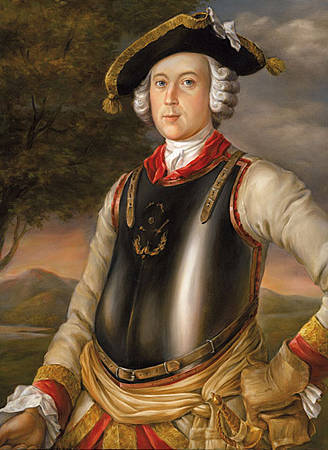
Image by
G. Bruckner
Step 2️⃣ 👣: Alfred, Lord Tennyson
"Alfred Tennyson, 1st Baron Tennyson, (; 6 August 1809 – 6 October 1892), was an English poet. He was the Poet Laureate during much of Queen Victoria's reign. In 1829, Tennyson was awarded the Chancellor's Gold Medal at Cambridge for one of his first pieces, "Timbuktu". He published his first solo..."

Image by Elliott & Fry
Step 3️⃣ 👣: Alfred Austin
"Alfred Austin (30 May 1835 – 2 June 1913) was an English poet who was appointed Poet Laureate in 1896, after an interval following the death of Tennyson, when the other candidates had either caused controversy or refused the honour. It was claimed that he was being rewarded for his support for the..."

Image by Russell & Sons
Step 4️⃣ 👣: Alfred Henry Miles
"Alfred Henry Miles (26 February 1848 – 30 October 1929) was a prolific Victorian-age author, editor, anthologist, journalist, composer and lecturer who published hundreds of works on a wide range of topics, ranging from poetry (The Poets and the Poetry of the Century, 10 vols. (London: Hutchinson,..."
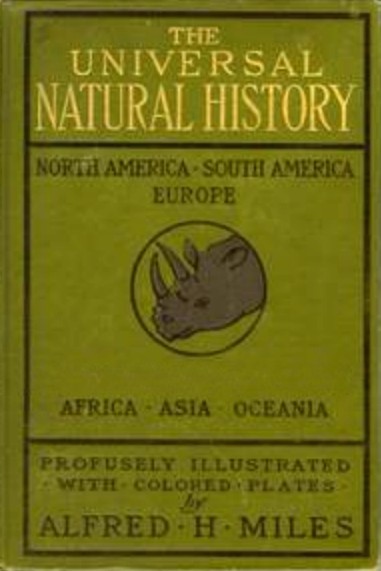
Image by Alfred Henry Miles (1848-1929)
Step 5️⃣ 👣: Project Gutenberg
"Project Gutenberg (PG) is a volunteer effort to digitize and archive cultural works, as well as to "encourage the creation and distribution of eBooks." It was founded in 1971 by American writer Michael S. Hart and is the oldest digital library. Most of the items in its collection are the full texts..."
0 notes
Text
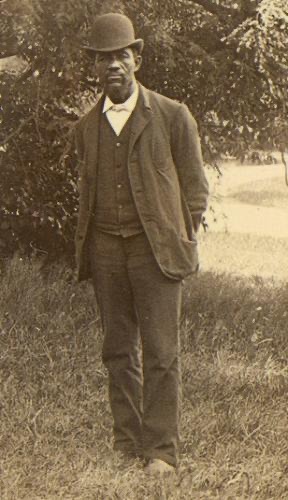
Solomon G. Brown (February 14, 1829 - June 26, 1906) was a poet, lecturer, scientific technician, and the first African American employee of the Smithsonian Institution. He played a significant role in the implementation of the first electric telegraph and was well-versed in the study of natural history.
Born in DC, he was the fourth of six children born to Isaac and Rachel Brown, both ex-slaves.
At the age of fifteen, he began working at the DC post office where he was assigned to assist Joseph Henry and Samuel F.B. Morse on the installation of the first Morse telegraph line in the nation. He was one of the technicians who helped set up the telegraph line between Baltimore and DC. He continued to work for Samuel F.B. Morse for the next seven years.
Beginning in 1852, at the newly opened Smithsonian Institution, he was hired as a general laborer. By 1864, he was a museum assistant, and by 1869, he was the registrar in charge of transportation, registry, and storage of animal specimens and materials received by the institution. He assisted in preparing maps and drawings for all Smithsonian lectures (1870-87). He worked under the first three secretaries of the institution.
While at the Smithsonian, he educated himself in the field of natural history. His association with the Smithsonian provided him with a plethora of information, which he passed on to scientific societies in Baltimore, DC, and Alexandria. He dedicated much of his time to poetry. He participated in readings throughout the DC area, and his poems were published in one of the leading African American newspapers of the day, the Washington Bee.
He was an activist, volunteering in various civic and educational programs aimed at advancing African Americans. He was a trustee of Wilberforce University and of the 15th Street Presbyterian Church in DC. He founded the Pioneer Sabbath School in the city and was superintendent of the North Washington Mission Sunday School. He was elected president of the National Union League. He served three consecutive one-year terms in the legislature of DC.
After 54 years of service at the Smithsonian Institute, he retired. #africanhistory365 #africanexcellence
1 note
·
View note
Text
Jensen's folly and the proof of "No Irish Need Apply" [Part 2]
Continued from part 1. This post was originally published on WordPress in June 2018.
Looking on newspapers.com, I found 3,047,608 matches for the words "no Irish need apply," with even a story about it in the Buffalo paper, The Weekly Economist, in 1843. Now, not all of those portended to ads. [2] Narrowing the search, covering the years of 1800 to 1860, I brought the total to about 113,000. The latter number may be inflated due to false drops since quoting the phrase itself only brings up 158 results, extending it to 1900 gives you about 1,400 results, over 60 of which are listed below. I also got some sources from the Library of Congress's Chronicling America collection of old newspapers, which are included in the below listing of varied ads.
1820s
June 29, 1828 ad in the New York City paper, The Evening Post
July 24, 1828 ad in the New York City paper, The Evening Post
August 8, 1828 ad in the New York City paper, The Evening Post
September 11, 1828 ad in the New York City paper, The Evening Post
October 8, 1828 ad in the New York City paper, The Evening Post
June 8, 1829 ad in the New York City paper, The Evening Post
June 19, 1829 ad in the New York City paper, The Evening Post
June 23, 1829 ad in the New York City paper, The Evening Post
October 27, 1829 ad in the New York City paper, The Evening Post
1830s
April 29, 1830 ad in the New York City paper, The Evening Post, related to the one a few days before
New York Herald attacks No Irish Need Apply adverts on July 30, 1830
1840s
May 18, 1841 ad in the New York City paper, New York Tribune
August 24, 1842 ad in the New York City's New York Tribune
February 7, 1844 ad in the Philadelphia paper, Public Ledger
January 7, 1847 ad in the Philadelphia paper, Public Ledger
April 23, 1847 ad in the Philadelphia paper, Public Ledger
November 4, 1847 ad in the Philadelphia paper, Public Ledger
January 25, 1848 ad in the Philadelphia paper, Public Ledger
October 28, 1848 ad in the Philadelphia paper, Public Ledger
July 16, 1849 ad in the New York City paper, New York Herald, reprinted from days before
1850s
February 25, 1850 ad in the Philadelphia paper, Public Ledger
March 11, 1850 ad in the Philadelphia paper, Public Ledger
August 6, 1850 ad in the Philadelphia paper, Public Ledger
January 13, 1851 ad in the New York City's New York Tribune
February 5, 1851 ad in the Baltimore Sun
March 13, 1851 ad in the New York Daily Herald
April 22, 1851 ad in the Baltimore Sun
July 24, 1851 ad in the Philadelphia paper, Public Ledger
December 31, 1851 ad in the Baltimore Sun, accompanied by another saying they are looking for someone who is white, but not Irish, as a cook
April 13, 1852 ads (top and bottom of image) in the Philadelphia paper, Public Ledger
May 14, 1852 ad in New York City's New York Tribune
June 21, 1852 ad in the Philadelphia paper, Public Ledger
August 26, 1852 ad in the Philadelphia paper, Public Ledger
October 11, 1852 ad in the Philadelphia paper, Public Ledger
December 31, 1852 ad in the New Orleans paper, The Times-Picayune
June 22, 1853, the Lancaster Ledger reports that the New York Herald is being sued for libel for attaching "no Irish may apply" to one of its ads, which the Ledger calls "queer"
June 2, 1853, the New York Herald criticizes "No Irish Need Apply" ads
July 30, 1853 ad in the Philadelphia paper, Public Ledger
February 19, 1854, the New York Herald talks about their ""No Irish Need Apply" advertisers"
March 30, 1854 ad in the Baltimore Sun
October 6, 1854 ad in the West Virginia paper, the Wheeling Daily Intelligencer
April 21, 1855 ad in the Freehold, New Jersey paper, the Monmouth Inquirer
May 18, 1855 ad in Baltimore Sun
September 18, 1855 ad in the Philadelphia paper, Public Ledger
October 17, 1855 ad in the Washington, D.C. Evening Star, likely related.
March 28, 1856 ad in the Baltimore Sun
February 14, 1857 ad in the New York Times
December 7, 1857 ad in New Orleans paper, The Times-Picayune
April 20, 1857 ad in the Baltimore Sun
March 20, 1858 ad in the New York Times
August 17, 1858 ad in the Baltimore Sun
October 1, 1858 ad in the Baltimore Sun, reprinted on October 2 and 4, at least
October 13, 1858 ad in New York Times
May 10, 1859 ad in the New York Times
September 21, 1859 ad in the New York Times
1860s
March 29, 1860 ad in the Brooklyn Daily Eagle
April 3, 1860 ads (here and here) in the Philadelphia paper, Public Ledger
June 8, 1860 ad in the Baltimore Sun, related is ad the day before
August 6, 1860 ad in the Cincinnati Daily Press
August 25, 1860 ad in the Philadelphia paper, Public Ledger
Ad and comment in Columbia Democrat and Bloomsburg General Advertiser
(Bloomsburg, Pennsylvania) on March 12, 1864
© 2018-2023 Burkely Hermann. All rights reserved.
Notes
[2] This is apart from mentions of it in 1878 to counter such sentiment (and in 1864), the Guardian (see here, here, here, and here), the Liverpool Mercury in 1854 (here and here), 1855 (also see here, here, here, ), 1857, 1858, 1859, and 1863, along with other mentions in English papers in 1844, 1847, and 1856. A comedy, in the 1850s, was even produced on this subject! In all, there are over 105,000 results for England alone, over 9,000 for Scotland, over 8,000 for Ireland, over 5,000 for Northern Ireland, over 4,700 for Australia, over 1,500 for Wales and almost 1,000 for Canada.
#irish history#irish americans#irish heritage#irish genealogy#newspaper clippings#1860s#1850s#1840s#1830s#1820s#wordpress#19th century
0 notes
Text
Letters of John Quincy Adams to His Son, on the Bible and Its Teachings - John Quincy Adams
00:00:00 00 Inscription and Preface00:04:44 01 Letter 100:15:27 02 Letter 200:25:30 03 Letter 300:36:02 04 Letter 400:46:30 05 Letter 500:57:47 06 Letter 601:08:42 07 Letter 701:20:23 08 Letter 801:30:11 09 Letter 901:40:26 10 The Wants of Man (a poem)
John Quincy Adams (July 11, 1767 – February 23, 1848) was the sixth President of the United States (1825–1829). He served as American diplomat,…

View On WordPress
#bible reading#bible truth#Christian#Christianity#Christians#Creator#God#Jehovah#Jesus Christ#Lord#preacher#President#Scripture#Scripture study#Scriptures#Yeshua
0 notes
Photo

12:51 AM EDT May 26, 2022:
Paul McCartney - "Another Day"
From the album Wings Greatest
(November 10, 1978)
Last song scrobbled from iTunes at Last.fm
Originally Apple 1829, released in the US February 22, 1971
--

0 notes
Note
who is Delphine LaLaurie?
(tw: death, slavery, racism)
Delphine LaLaurie was a Creole woman, loving in high society in 1800s New Orleans. Outwardly to all she was a respectable woman. However there were a few rumours of her at this time. She had been cautioned by the law about the death of a young slave girl at her house. Delphine had chased the girl with a whip, causing her to leap from the house's roof and die of her wounds. The girl, Lia or Leah, was 12. Delphine got off with a fine and had to sell 9 slaves (which she bought back) & nobody said any more on it.
Then came a fire at her house in April 1834. As men rushed to save her house, they asked her if there was anybody still left inside. She said no but her neighbours contested that, shouting that there were multiple slaves still in the house. Delphine refused to hand over the key to her attic where the slaves slept. Men broke into the house and broke down the door to save the slaves. What was behind the door was far more harrowing than anybody could have ever believed. They found the slaves in terrible conditions, broken and tortured which such horrific injuries that even the most ardent supporters of slavery could not condone. Delphine and her family fled New Orleans and went into exile in Paris.
But we shall not dwell on her. Her victims deserve our attention, not one batshit crazy bitch who hopefully is burning in the depths of Tartarus.
Juliette (c. 1820–February 21, 1833)
Florence (c. 1821–February 16, 1831)
Jules (c. 1827–May 29, 1833)
Leontine (c. 1829–August 26, 1831)
Bonne (c. 1803–February 7, 1833)
Lia/Leah
The Unnamed men, women and children
Déanann Dia iad a chaomhnú agus a chosaint i sábháilteacht agus i ndeolchaire don tsíoraíocht atá le teacht.
45 notes
·
View notes
Text

The mental and physical impacts of solitary confinement have been clear for two centuries. In 1829, Pennsylvania Quakers opened the first prison designed for solitary, hoping to inspire reflection in the inmates. Instead, many went crazy or committed suicide. Thirteen years later, Charles Dickens made his first trip to America, and after seeing it first hand, solitary confinement shocked a writer whose bleak perspective inspired an adjective for intolerable suffering. “He is a man buried alive,” he wrote.
In the century and a half since, multiple international agreements have codified the practice as inhumane. In 2011, Juan Mendez, the U.N. special rapporteur on torture — who was himself jailed and tortured by the Argentinean military dictatorship for more than a year in the 1970s — declared that more than 15 days in solitary constitutes torture.
“Solitary confinement is recognized as difficult to withstand; indeed, psychological stressors such as isolation can be as clinically distressing as physical torture,” wrote Jeffrey L. Metzner and Jamie Fellnerin in the Journal of the American Academy of Psychiatry and the Law, in a paper about the medical ethics of physicians who participate in punitive isolation measures.
According to a report by Citizens for Prison Reform, there are 3,200 people in isolation in Michigan for more than 20 hours a day among the state prison population, like Richard Goddard, who has been in isolation for 47 years; James Miller, who has been segregated from the general population for about 36; and Daniel Henry, for 12. Clarence Henderon, who at 67 had been in isolation has been confined to a wheelchair due to severe arthritis. He allegedly goes months without going outside. “It’s just torture,” says Mario Lee, who goes by the name Akesi and has been incarcerated since 2005, currently serving time at the Ionia Correctional Facility.
Chris Gautz, a spokesperson for the MDOC, denies that the department regularly keeps inmates in solitary confinement for years. (A request for comment on the whereabouts of the individuals in Silenced was forwarded to the state’s FOIA office, and we’ll update if we hear back). “As of February of this year, there was one prisoner who has been in [administrative segregation] for more than one year, but less than two, out of 32,000 prisoners,” Gautz said. But Jessica Sandoval, senior campaign strategist with the national Unlock the Box campaign, says the MDOC fudges those numbers by labeling isolation a variety of technical terms, like Mental Health Unit; Observation; temporary segregation. And Alternative to Segregation (START program).
Akesi, who was recently moved to the START program, says the difference is meaningless. “The program is classified as general population. In reality, it’s administrative [segregation]. The only distinguishing features is that we are required to attend and participate in one hour of group therapy sessions once a week,” he says. “On the other hand, the similarities to seg are many. We are allowed one hour of outdoor recreation five days a week, confined to individual enclosures with concrete floors and enclosed by a steel and wire mesh cage.” He says they’re denied access to any congregate activities including religious services. “We spend between 23 and 24 hours per day in our cells. By no stretch of the imagination can the department of corrections claim that this program is general population or otherwise an alternative to segregation.”
“As social (i.e. human beings) one of the most severe punishments humanly possible that society can mete out to a human is to banish and condemn us to the tombs for the living — or otherwise subject us to extreme social isolation and sensory deprivation,” Akesi wrote in 2020 from the Ionia Correctional Facility in Ionia, Michigan. “It’s endless torture, psychological and physical.”
“This is the techno jargon that keeps the system opaque. All these euphemisms are for essentially solitary confinement,” Sandoval says. She says anything that forces an inmate to stay in isolation for longer than sleeping hours should be defined as solitary. (Gautz told Rolling Stone he didn’t have that information and forwarded the query to the department’s FOIA office.) The Michigan Department of Corrections counts 835 inmates in administrative, or long-term segregation, and 130 in punitive solitary detention, as a short term punishment. The race breakdown is stark: more than 70 percent of inmates placed in long term solitary are Black.
The prisoners’ descriptions are remarkably consistent: they describe severe mental health problems arising from solitary, from hallucinations to paranoia to suicidal ideation. One inmate reports losing his vision after staring at nothing in the near distance for so long. Another, Williams says, was screaming on the phone; he’d forgotten how to talk at a normal volume.
Williams points out that it’s not just the “worst of the worst” being held in isolation — Hannibal Lecters who would wreak havoc if they weren’t segregated. Inmates can get thrown in the hole for any reason, she says, or no reason at all. She claims it’s entirely based on the whim of the guards. “One man was sent to isolation unit after knocking over a glass of water,” she claims. (Gautz, the MDOC spokesperson, denied that guards put prisoners in solitary without due process or a just reason.)
Williams also notes that many facilities are in rural, almost entirely white towns: in some cases, the prison is the main industry. “You’re taking Black people to extremely isolated places. The town survives off of these Black bodies.”
“The further you go up North… its like some parts of the South in the 50’s and 60’s,” writes inmate Andraus McCloud. “The KKK turned in their robes for MDOC uniforms,” writes inmate Anthony Richardson. “Nobody is watching while they do their hate practices.”
When Danielle Dunn, a real estate broker, spoke to her little brother, 38-year-old Jonathan Lancaster, in February of 2019, he whispered the entire time. “There was a change in his voice. Clearly he was having mental health issues,” she tells Rolling Stone. Lancaster had been thrown in solitary after a scuffle with another inmate, and had become increasingly paranoid. “He was saying there was gas pumped into his cell. That his food was being poisoned. I said, ‘Are you OK? It sounds like you’re cracking up a little bit.” Lancaster got silent, Dunn recalls. “Then he whispered again, ‘They’re going to kill me.’”
Even as Lancaster started losing weight and continued to act erratically — he suffered from a variety of mental illnesses, his sister says, including schizophrenia — his sister alleges that prison staff failed to get Lancaster proper medical treatment. He began to hallucinate, crouch in the fetal position, and refused food and water. The Detroit Free Press reported that he lost 26 percent of his body weight in three weeks, dropping 51 pounds, according to the lawsuit.
“They didn’t even know why he was still in solitary confinement,” Dunn says. She begged staff to give him proper care but claims she was told he was “physically fine.” March 8th, 2019, he was pepper sprayed and put in an observation room, where he didn’t have access to water, according to the lawsuit. On March 11th, they cleared him for a hospital visit. Early that morning, they strapped him into a restraint chair and left him in his cell for several hours. At 12:50 he was found unresponsive and later declared dead. (Lancaster’s family is suing MDOC staff for wrongful death; Gautz declined to comment on the ongoing litigation.)
“My brother was severely tortured,” Dunn says, tearing up. “They beat him. There were bruises all over him. Pepper sprayed, beat, when he was unresponsive. They sat there and they literally watched him suffer and die.” Her mother was put in a mental health hospital. “It’s all but killed my mother. She’s suffering terribly.”
“The cruelty, leaving him to die in his own waste, suffering,” Dunn says, of her brother.
Surviving in solitary can be its own cruelty. Daniel Henry has spent more than a decade in segregation and, he says, he’s been told he’s never getting out. “It’s been a long 12 years in solitary at ICF and I have learned so much about the darker side of human nature and how cruel people can become when there is no real accountability or oversight,” Henry wrote to Willams. “I have also learned a lot about myself. And I’ve met many people in here and out there who have taught me how to sympathize with the next man’s pain and suffering.”
“Other countries do not utilize solitary confinement like we do let alone incarcerate their citizens for such lengthy sentences that virtually remove any hope for a future life outside of the criminal justice system,” Henry added.
He, and others, worry about Richard Goddard, who’s spent almost 50 years in isolation. “The man is the most kind, caring and humble human being I’ve ever met and he clearly presents no threat to either himself or the MDOC any longer,” says Henry. “The appearance is that they want us to suffer as much as possible on top of being confined to a small space for years.”
Williams hopes to turn outrage over conditions into action; the website has a “Take Action” page that lets people share their stories and lobby political leaders, like Michigan’s Democratic Governor Gretchen Whitmer.
“I am hoping that public pressure makes the MDOC admit that there’s a huge problem, and actually work toward fixing it,” she tells Rolling Stone.
She wishes elected officials could really see the conditions they perpetuate with their inaction. “I want legislators to visit these prisons in July or August, to step inside of a segregation cell and close the door when it’s over 100 degrees and see how long they last.”
9 notes
·
View notes
Photo


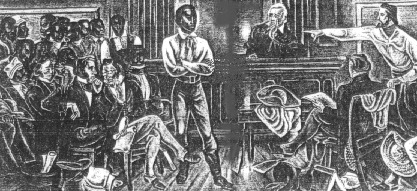
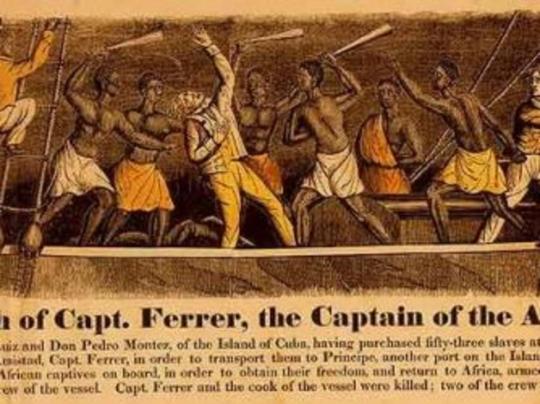

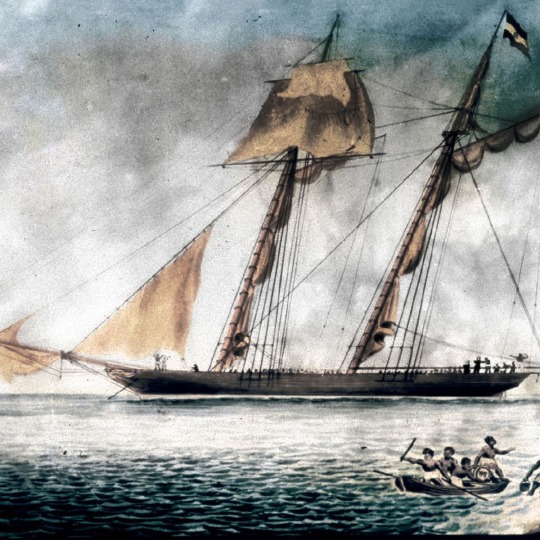
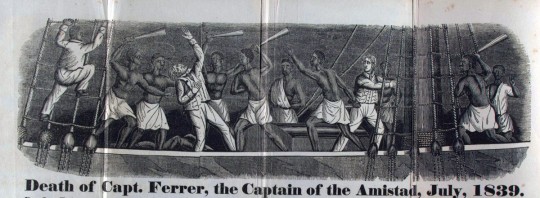
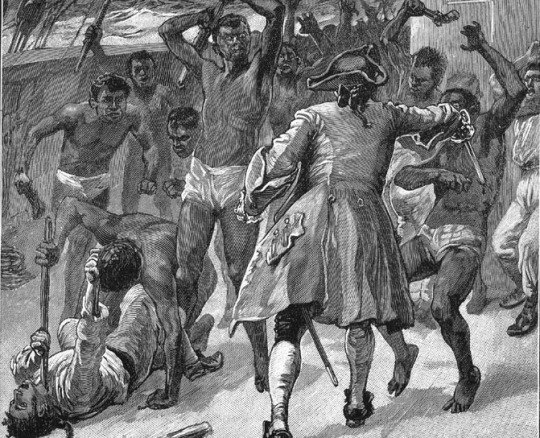

THIS DAY IN HISTORY
March 09, 1841
Supreme Court rules on Amistad slave ship mutiny case
At the end of a historic case, the U.S. Supreme Court rules, with only one dissent, that the enslaved Africans who seized control of the Amistad slave ship had been illegally forced into slavery, and thus are free under American law.
In 1807, the U.S. Congress joined with Great Britain in abolishing the African slave trade, although the trading of enslaved people within the U.S. was not prohibited. Despite the international ban on the importation of enslaved Africans, Cuba continued to transport captive Africans to its sugar plantations until the 1860s, and Brazil to its coffee plantations until the 1850s.
On June 28, 1839, 53 enslaved people recently captured in Africa left Havana, Cuba, aboard the Amistad schooner for a life of slavery on a sugar
plantation at Puerto Principe, Cuba. Three days later, Sengbe Pieh, a Membe African known as Cinque, freed himself and the other enslaved people and
planned a mutiny. Early in the morning of July 2, in the midst of a storm, the Africans rose up against their captors and, using sugar-cane knives found
in the hold, killed the captain of the vessel and a crewmember. Two other crewmembers were either thrown overboard or escaped, and Jose Ruiz and
Pedro Montes, the two Cubans who had purchased the enslaved people, were captured. Cinque ordered the Cubans to sail the Amistad east back to
Africa. During the day, Ruiz and Montes complied, but at night they would turn the vessel in a northerly direction, toward U.S. waters. After almost
nearly two difficult months at sea, during which time more than a dozen Africans perished, what became known as the “black schooner” was first spotted
by American vessels.
On August 26, the USS Washington, a U.S. Navy brig, seized the Amistad off the coast of Long Island and escorted it to New London, Connecticut. Ruiz and Montes were freed, and the Africans were imprisoned pending an investigation of the Amistad revolt. The two Cubans demanded the return of their supposedly Cuban-born enslaved people, while the Spanish government called for the Africans’ extradition to Cuba to stand trial for piracy and murder. In opposition to both groups, American abolitionists advocated the return of the illegally bought enslaved people to Africa.
The story of the Amistad mutiny garnered widespread attention, and U.S. abolitionists succeeded in winning a trial in a U.S. court. Before a federal district court in Connecticut, Cinque, who was taught English by his new American friends, testified on his own behalf. On January 13, 1840, Judge Andrew Judson ruled that the Africans were illegally enslaved, that they would not be returned to Cuba to stand trial for piracy and murder, and that they should be granted free passage back to Africa. The Spanish authorities and U.S. President Martin Van Buren appealed the decision, but another federal district court upheld Judson’s findings. President Van Buren, in opposition to the abolitionist faction in Congress, appealed the decision again.
On February 22, 1841, the U.S. Supreme Court began hearing the Amistad case. U.S. Representative John Quincy Adams of Massachusetts, who served as the sixth president of the United States from 1825 to 1829, joined the Africans’ defense team. In Congress, Adams had been an eloquent opponent of slavery, and before the nation’s highest court he presented a coherent argument for the release of Cinque and the 34 other survivors of the Amistad.
On March 9, 1841, the Supreme Court ruled that the Africans had been illegally enslaved and had thus exercised a natural right to fight for their freedom. In November, with the financial assistance of their abolitionist allies, the Amistad Africans departed America aboard the Gentleman on a voyage back to West Africa. Some of the Africans helped establish a Christian mission in Sierra Leone, but most, like Cinque, returned to their homelands in the African interior. One of the survivors, who was a child when taken aboard the Amistad, eventually returned to the United States. Originally named Margru, she studied at Ohio’s integrated and coeducational Oberlin College in the late 1840s, before returning to Sierra Leone as evangelical missionary Sara Margru Kinson.
4 notes
·
View notes
Photo





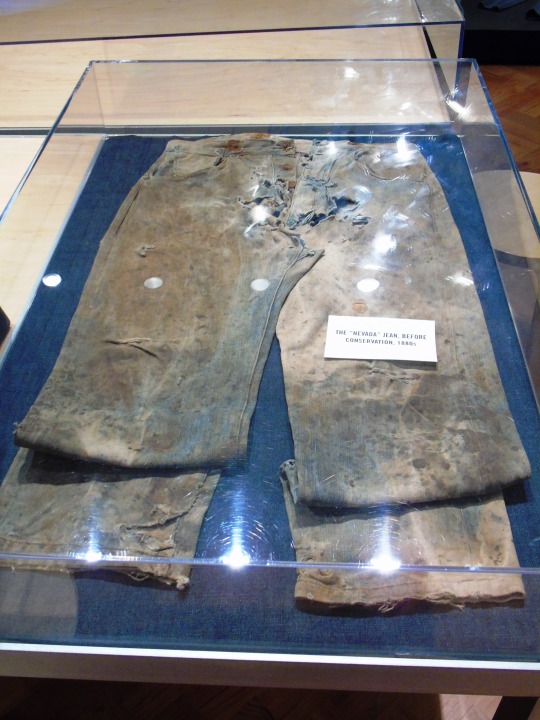




Levi Strauss Day
They’re comfy. They last for years and years. They don’t require dry-cleaning or any other kind of special treatment. They’re perfect for a number of occasions, from a trip to the grocery store, to a walk in the park, to an evening at the pub, to a number of even semi-formal social occasions. They’re incredibly versatile, meaning they look good with pretty much everything, from t-shirts to smart blazers. In fact, you can’t imagine life without them at all.
What are we talking about? Jeans, of course! This iconic garment is more than deserving of it own holiday, as is Mr. Levi Strauss, a man without whom jeans as we know them might not exist at all.
“In the old days, people used to risk their lives in India or in the Americas in order to bring back products which now seem to us to have been of comically little worth” – Levi Strauss.
The History of Levi Strauss Day
Levi Strauss was a German-American businessman born in Bavaria on February 26th, 1829, who came to the United States with his family the mid-1800s when he was 18 years old. Strauss began as a dry goods wholesaler in San Francisco, California, where he sold various items such as clothing, bedding, bags and handkerchiefs to settlers, many of whom had arrived in California to take part in the gold rush. Needless to say, the hard physical labor required of the miners of the day and those building new railroads made it difficult for them to find clothing that would last for more than a few months without falling apart at the seams. One day in 1870, one of Strauss’ clients, a tailor named Jacob W. Davis was approached by a woman who needed a pair of exceptionally strong working pants for her husband, a woodcutter. Her request prompted Davis to make a pair of pants from the denim he’d bought at Strauss’ shop that he then strengthened with copper rivets to reinforce the stitching. Word of the new article of clothing and its endurance spread fast, and soon Davis was not able to keep up with the demand for his invention, nor did he have the resources to open a larger tailor shop or obtain a patent. Falling further and further behind and afraid someone else would steal his idea, Davis decided to ask for Strauss’ financial backing in the filing of a patent application. Strauss agreed, the patent was issued, the two men became business partners, and Levi Strauss & Co was born.
How to Celebrate Levi Strauss Day
Levi Strauss’ story is considered to be the quintessence of the “American Dream”, a belief that all men and women were created equal and that hard work, ambition and creativity are all that is needed to become successful, both financially and otherwise. Levi Strauss’ family was anything but wealthy, with his father making just enough money as a peddler to keep the family afloat until he died of tuberculosis, a tragedy that plunged the Strauss family into poverty. Regardless of any and all setbacks, however, Levi Strauss managed to make an enormous amount of money. Strauss was not the stereotype of a stingy, rich miser, however–far from it. Throughout his life, he made numerous donations to various orphanages and other charity organizations. That’s why a great way to celebrate this day would be to read the biography of Levi Strauss or any other man or woman who has achieved success through hard work and dedication, and then used his or her money and influences to help others.
Source
#Levi Strauss Day#LeviStraussDay#born#birthday#26 February 1829#anniversary#history#clothes#jeans#my favorite jeans' brand is Levi's#original photography#summer vacation#travel#Napa#Lyman Rest Stop#Echo Reservoir#DeWitt#logo#San Francisco#HQ#Levi Strauss & Co#shorts#Lusk#Santa Barbara#USA
1 note
·
View note
Photo










House of Habsburg: Anna Plochl
Anna was born as the oldest of thirteen children to postmaster Jakob Plochl and his wife Maria Anna Pilz. In English sources, he lastname is often given as Plöchl but all German sources I found, including the official Habsburg homepage, refer to her as Plochl.
After the death of her mother, Anna took over the household duties. On August 22nd, 1819, Anna, only fifteen at the time, met Archduke Johann of Austria, already 37 at the time, for the first time. Somewhen during the next four years a relationship between them must have blossomed because Johann sought his brother Emperor Franz I.’s permission in 1823 for the first time. He denied to sanction the marriage to a commoner.
Despite The Emperor’s decision, Anna moved to Vordernberg where Johann owned a pre-modern blast furnace. He was constantly on the road in Styria as well as traveling to court in Vienna. Anna in the mean time became the caretaker of Brandhof Castle from April 25th, 1824, onwards. She was known for her traditional Styrian recipes and they are still considered a specialty until this day.
On February 18th, 1829, the now 47-year-old Johann married the 25-year-old Anna morganatically after The Emperor had finally given them permission. But Johann was not allowed to make his marriage public until four years later. In 1834, Anna received the title of Baroness of Brandhofen, named after her father’s estate.
After ten years of marriage, the couple welcomed their first and only child Franz. When he was 5 or 6, Johann was successful in persuading The Prince of Metternich to campaign for the title of Count of Meran for his son. Anna received the same title five years later too and was from 1850 known as Countess of Meran.
Johann died May 11th, 1859, which left Anna a widow at 45. She continued his charity work in Styria and would survive him for 26 years. Anna died in the same place she was born: Aussee. She is buried next to her husband in a mausoleum in Schenna near Meran.
// Anna Maria Mühe in Anna and the Prince (2009)
#perioddramaedit#women in history#1800s#European history#historyedit#house of habsburg#House of Habsburg-Lorraine#Austrian history#Anna Plochl#19th century#victorian era#Anna and the Prince#Geliebter Johann Geliebte Anna#Anna und der Prinz#morganatic wives
136 notes
·
View notes
Text
2nd Regnant Queen and 29th Monarch of Portugal (9th of the Bragança Dynasty): Queen Maria II of Portugal, “The Educator/The Good Mother”
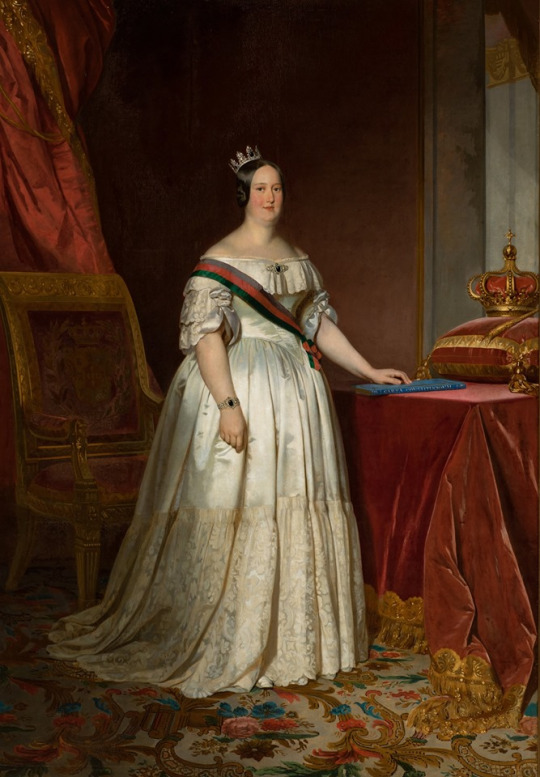
Reign: 26 May 1834 – 15 November 1853
Acclamation: 20 September 1834
Predecessor: Pedro IV
Maria II (4 April 1819 In Rio de Janeiro – 15 November 1853 in Lisbon) "the Educator" ("a Educadora") or "the Good Mother" ("a Boa Mãe"), reigned as Queen of Portugal from 1826 to 1828, and again from 1834 to 1853. Born in Rio de Janeiro, she was the first child of King Pedro IV of Portugal (Pedro I of Brazil) and his first wife, Queen Maria Leopoldina, and thus a member of the House of Bragança. One of the two surviving children born when Pedro was still heir apparent to Portugal, she inherited Portuguese titles and was placed in the line of succession to the former Portuguese throne, even after becoming a member of the Brazilian Imperial Family, from which she was excluded in 1835 after her definitive ascension to the Portuguese throne.

Maria II was born Maria da Glória Joana Carlota Leopoldina da Cruz Francisca Xavier de Paula Isidora Micaela Gabriela Rafaela Gonzaga on 4 April 1819 in the Palace of São Cristóvão

in Rio de Janeiro, Kingdom of Brazil. She was the eldest daughter of the Prince Pedro de Alcântara, future King of Portugal as Pedro IV and first Emperor of Brazil as Pedro I, and his first wife Maria Leopoldina (née Archduchess Caroline Josepha Leopoldine of Austria), herself a daughter of Francis II, Holy Roman Emperor. She was titled Princess of Beira upon her birth. Born in Brazil, Maria was the only European monarch to have been born outside of Europe, though she was still born in Portuguese territory.
The death of Maria's grandfather, King João VI, in March 1826 sparked a succession crisis in Portugal. The king had a male heir, Pedro,

but Pedro had proclaimed the independence of Brazil in 1822 with himself as Emperor. The late king also had a younger son, Miguel,
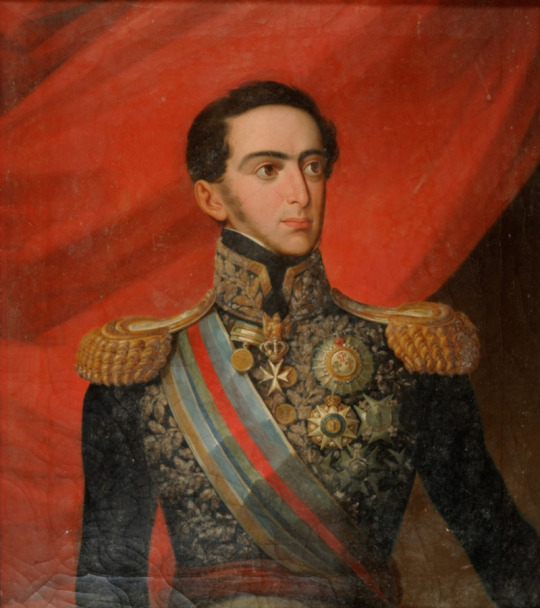
but he was exiled to Austria after leading a number of revolutions against his father and his liberal regime.
Before his death, the king had nominated his favourite daughter, Isabel Maria, to serve as regent until "the legitimate heir returned to the kingdom" — but he had failed to specify which of his sons was the legitimate heir: Pedro, the liberal Emperor of Brazil, or Miguel, the absolutist exiled prince.
Most people considered Pedro to be the legitimate heir, but Brazil did not want him to unite Portugal and Brazil's thrones again. Aware that his brother's supporters were ready to bring Miguel back and put him on the throne, Pedro decided for a more consensual option: he would renounce his claim to the Portuguese throne in favour of his daughter Maria (who was only seven years old), and that she was to marry her uncle Miguel, who would accept the liberal constitution and act as a regent until his niece reached majority.
Miguel pretended to accept, but upon his arrival in Portugal he immediately deposed Maria and proclaimed himself king, abrogating the liberal constitution in the process. During his reign of terror, Maria traveled to many European courts, including her maternal grandfather's in Vienna, as well as London and Paris.

Maria's first reign was interrupted by the absolutist uprising led by her uncle, fiancé and regent Miguel, who proclaimed himself King of Portugal on 23 June 1828. Then began the Liberal Wars that lasted until 1834, the year in which Maria was restored to the throne and Miguel exiled to Germany.
The Marquis of Barbacena,
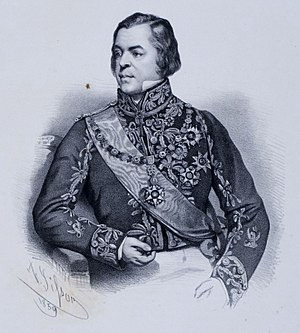
arriving in Gibraltar with the princess on 3 September 1828, was informed by an emissary of what was happening in Portugal. He had the foresight to understand that Miguel had come from Vienna determined to put himself at the head of the absolutist movement, advised by Prince Klemens von Metternich,

who was directing European politics, and so it was dangerous for the young Queen to go to Vienna. Taking responsibility, he changed the direction of the journey, and departed for London, where he arrived on 7 October. English policy was not conducive to its purpose. The Duke of Wellington's
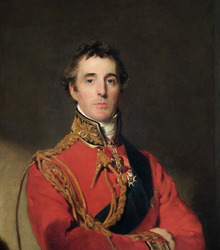
office openly sponsored Miguel, so the asylum the Marquis had sought was not safe. Maria II was received in court with the honors due to her high hierarchy, but the British prevented their subjects there emigres to go to reinforce the garrison of the island Terceira.
Miguel's coup d'état had not gone unrevealed. On 16 May 1828, the garrison of Porto revolted, and in Lagos an infantry battalion. The revolts were stifled. Saldanha, Palmela, and others, who had come to take charge of the movement in Porto, re-embarked on Belfast ship, which had brought them; the Porto garrison, reinforced by the academic volunteers of Coimbra and other liberal troops, emigrated to Galiza and from there to England. At the head of a small liberal expedition, the Marquis of Saldanha attempted to disembark in Terceira, Azores, but was not allowed to take the English cruise, whose vigilance he could not avoid for some time after the Count of Vila Flor, later of Terceira, was able to disembark. In time, because in August 1829 appeared in front of the island a huge Miguelist squad that sent to soil a body of disembarkation. Then there was the Battle of August 11 in the village of Praia, where the miguelists were defeated. When the emigrants in England received the news of the victory, they felt great enthusiasm. They soon lost hope of knowing that the young queen was returning to the Brazilian Empire to her father. In fact, the situation of Maria II in the English court, next to the ministry in the power, became embarrassing and humiliating. The Queen left London to meet her future stepmother, Amélie of Leuchtenberg.
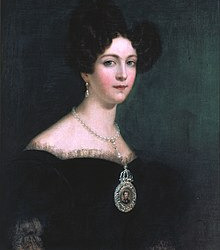
They left together on 30 August 1829 for Rio de Janeiro, arriving on 16 October.
The constitutional cause was thought to have been lost. The dispersed emigres (France, England and Brazil) were divided into rival factions. Only Terceira Island recognized the constitutional principles, and even there appeared miguelists guerillas. France was ready to recognize Miguel's government when the revolution of July broke out in Paris in 1830, which encouraged the Portuguese liberals.
In 7 April 1831, Pedro IV abdicated the imperial crown of Brazil on behalf of his son Pedro II,
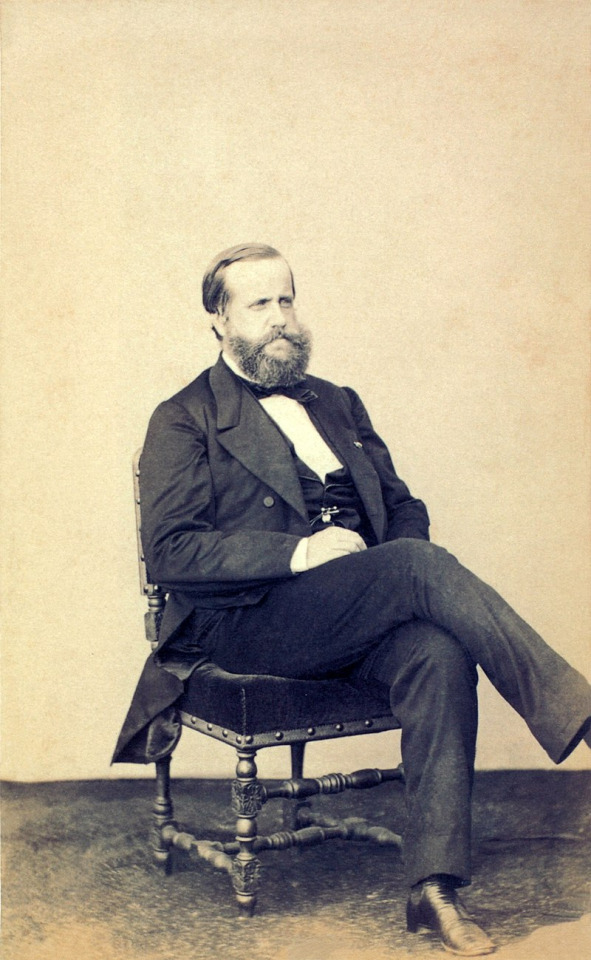
Maria's younger brother, and came to Europe with his daughter and his second wife, to support his daughter's rights to the crown from Portugal and joined the forces loyal to Maria in the Azores in their war against Miguel. He took the title of Duke of Bragança, and Regent in her name.
Almost at the same time the regency of the Ilha Terceira, named by Pedro and composed of the Marquis of Palmela, the Count of Vila Flor and José António Guerreiro, prepared an expedition that soon took possession of the Azores. While extending the constitutional territory, Pedro disembarked in France, being welcomed with sympathy by the new government and by Louis Philippe I.
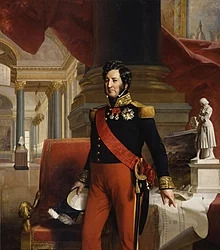
Miguel's government had defied the immunities of French subjects, had not at once satisfied the complaints of the French government, which had sent a squadron commanded by Admiral Roussin to force the bar of Lisbon and impose humiliating conditions of peace.
Pedro left his daughter in Paris to finish her education, delivered to her stepmother, Empress Amélie, with good masters, and left for the Azores at the head of an expedition organized on the island of Belle Isle, bringing his supporters together. Arriving in the Azores on 3 March 1832, he formed a new ministry, assembled a small army, whose command he gave to the Count of Vila Flor, and carried him aboard a squadron which he delivered to the English officer Sartorius, and departed for mainland Portugal. July 8 at Memória Beach in Matosinhos. It was followed by the Siege of Porto and a series of battles until, on 24 July 1833, the Duke of Terceira entered victorious in Lisbon, having won the Battle of Cova da Piedade the day before. Porto and Lisbon, the main cities, were in the power of the liberals. Pedro came to Lisbon, and summoned his daughter from Paris, forcing his brother, Miguel to abdicate in 1834. Maria was thereupon restored to the throne, and obtained an annulment of her betrothal. Soon after her restoration to the throne, her father died from tuberculosis.
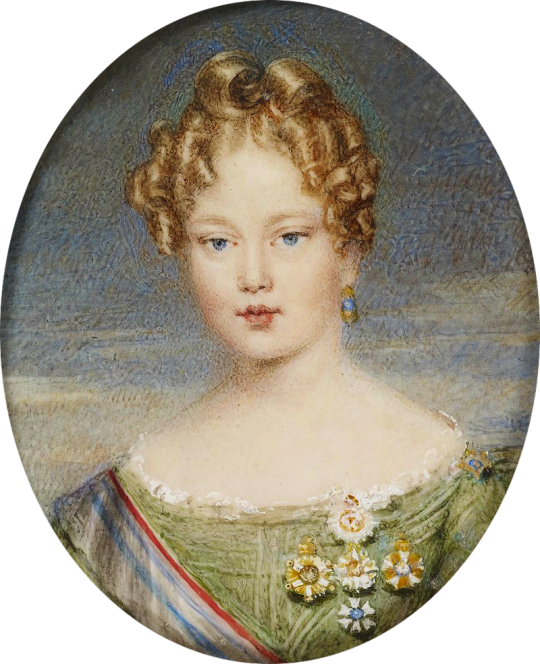
On 7 February 1833, in order to protect the Queen, the 2nd Lancers Regiment was created, first known as the Regimento de Lanceiros da Rainha (Queen's Lancers Regiment), with the motto Morte ou Glória, "Death or Glory" (the same as the 17th Lancers, since Lt. Col. Sir Anthony Bacon was its first commander), a fortunate coincidence since the queen's name was Maria da Glória.
Occupying the Portuguese throne, Maria II was still heir presumptive to her brother Pedro II as Princess Imperial of Brazil, until her exclusion from the Brazilian line of succession by law no. 91 of 30 October 1835.

Maria married Auguste, Duke of Leuchtenberg,

son of Eugène de Beauharnais
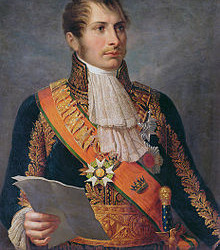
and grandson of the Empress Josephine of France,

on 26 January 1835, at the age of fifteen. However, he died only two months later, on 28 March 1835.
On 9 April 1836, she married the cultured and able Prince Ferdinand of Saxe-Coburg and Gotha. In accordance with Portuguese law, Ferdinand received the title of king upon the birth of their first child and heir, Pedro.
In 1842, Pope Gregory XVI

presented Maria with a Golden Rose.

Maria's reign saw a revolutionary insurrection on 16 May 1846, but this was crushed by royalist troops on 22 February 1847, and Portugal otherwise avoided the European Revolution of 1848. Maria's reign was also notable for a public health act aimed at curbing the spread of cholera throughout the country. She also pursued policies aimed at raising the levels of education throughout the country.
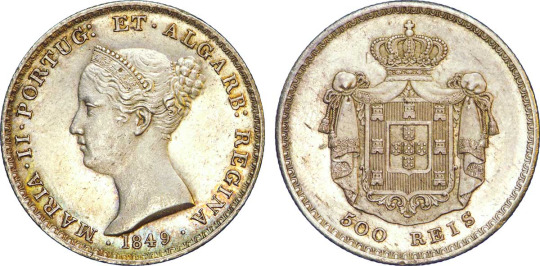
From her first pregnancy, at the age of eighteen, Maria II faced problems in giving birth, with prolonged and extremely difficult labor. An example of this was her third gestation, whose labor lasted 32 hours, after which a girl was baptized in articulo mortis with the name of Maria (1840).
At 25 years of age and in her fifth gestation, the sovereign became obese and her births became even more complicated. In 1847, the fetal distress that preceded the birth of her eighth child – the Infante Augusto, Duke of Coimbra – brought to the world a child "quite purple and with little breathing".
The dangerous routine of successive pregnancies, coupled with obesity (which eventually caused her heart problems) and the frequency of dystocic births (worrisome, especially as a multiparous woman) led doctors to warn the queen about the serious risks she would face in future pregnancies. Indifferent to the warnings, Maria II merely replied: "If I die, I die at my post."
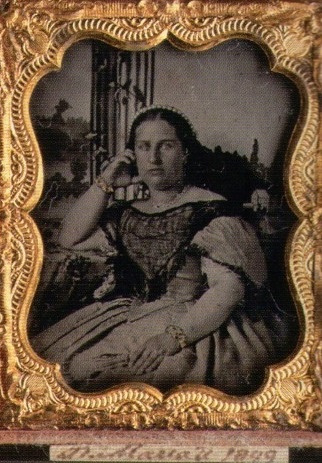
On 15 November 1853, thirteen hours after the onset of labor of the stillborn infant Eugenio, her eleventh child, Maria II died at the age of 34. The announcement of death was published in the Government Gazette of November 16, 1853:
“Paço das Necessidades, November 15, 1853, at half an hour after noon.
Her Majesty the Queen began to notice announcements of childbirth at nine-thirty on the night of the day. Difficulties appeared in the progress of the same childbirth, which forced the doctors to resort to operations, for which the extraction of an infant was obtained, of time, which received the baptism before being extracted.
The result of these operations took place at ten o'clock in the morning. Unfortunately, after an hour and a half, Her Majesty, exhausted from all strength, declared "I surrender my soul to God after having received all the sacraments."
In a letter dated November 28, 1853, the Duchess of Ficalho, the queen's maid, reported the outcome to her brother, the 2nd Earl of Lavradio:
“At two o'clock after midnight from the 14th to the 15th, I was ordered to go to the Palace, where I arrived at about three o'clock. I found the Empress in the Queen's room, where I immediately entered, thinking Her Majesty troubled and even little then we left the immediate room and asked Teixeira what he thought, telling us: "Your Majesty is going well, but slowly." I did not like it, and it was like that, until Teixeira called the doctors, who were out and who had not seen the Queen, and as soon as they examined her, the horrible operation was decided: the doctors were Teixeira, Farto, Kessler, Elias and Benevides. Kessler immediately dismissed the case as very dangerous. The operation was begun. I climbed onto the bed. On the right side, the Empress, full of tears; the Queen, with no fainting, but with a very bad opinion, and, complaining that she was suffering enough, said in her natural voice: "O Teixeira, if I am in danger, tell me, do not deceive me."
Queen Maria II is remembered as a good mother and a kind person who always acted according to her convictions in her attempt to help her country. She was later given the nickname "The Good Mother."

She was buried in the Bragança Pantheon,in Monastery of São Vicente de Fora. :

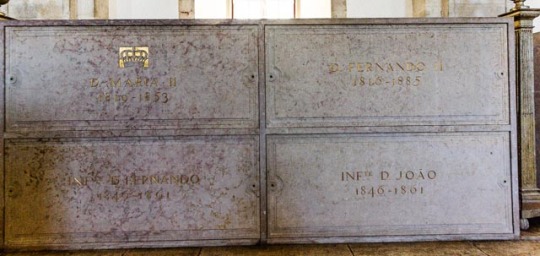
Maria first married Auguste Charles, 2nd Duke of Leuchtenberg, son of Eugène de Beauharnais, grandson of Empress Josephine, who died soon after arriving in Portugal. She then married Ferdinand of Saxe-Coburg and Gotha, son of Prince Ferdinand Georg August of Saxe-Coburg and Gotha and his wife Princess Maria Antonia Koháry de Csábrág.
Pedro (16 Setember 1837 - 11 November 1861) Succeeded his mother as Pedro V, King of Portugal.
Luís (31 October 183819 October 1889) Succeeded his brother, Pedro, as King of Portugal.
Infanta Maria (4 October 1840) Stillborn daughter.
Infante João (16 March 1842 - 27 December 1861) Duke of Beja
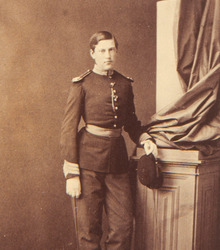
Infanta Maria Ana (21 August 1843 - 5 February 1884) Married King George of Saxony and was the mother of King Frederick August III of Saxony.
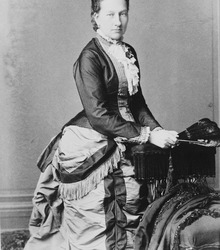
Infanta Antónia (17 February 1845 - 27 December 1913) Married Leopold, Prince of Hohenzollern, and was the mother of King Ferdinand I of Romania.

Infante Fernando of Portugal (23 July 1846 - 6 November 1861) Died of cholera at age 15.
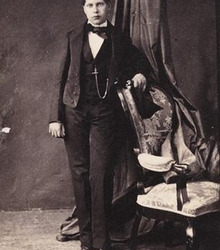
Infante Augusto (4 November 1847 - 26 September 1889) Duke of Coimbra

Infante Leopoldo (7 May 1849) Stillborn son.
Infanta Maria da Glória (3 February 1851) Stillborn daughter
Infante Eugénio (15 November 1853) Died some hours after the death of his mother.
10 notes
·
View notes
Text
February History
February 26
1616 - Galileo Galilei was formally banned by the Roman Catholic Church from teaching or defending the view that the earth orbits the sun.
1815 - Napoleon Bonaparte escaped from Elba.
1829 - Levi Strauss was born. He never married, so, ironically, he didn't get to pass his genes on to the next generation.
1870 - New York City's first pneumatic-powered subway line, created by Alfred Beach, was opened to the public.
1909 - Kinemacolor, the first successful color motion picture process, was first shown to the general public at the Palace Theatre in London with 21 short films.
1919 - 800,000 acres of the Grand Canyon, already a national monument, was designated a national park under President Woodrow Wilson
1929 - President Calvin Coolidge signed into law a bill establishing the Grand Teton National Park, in Wyoming.
1946 - Finnish observers reported the first of thousands of sightings of ghost rockets.
1993 - The first of the World Trade Bombings occured , the bomb went off in a parked truck under the North Tower. The bombing killed six and injured over a thousand people
1995 - Selena Quintanilla-Perez performed her last concert in Houston before being shot by her manager.
2005 - Halle Berry accepted her Razzie Award at the 25th annual ceremony at Hollywood’s historic Ivar Theatre.
2012 - Trayvon Martin, an African-American teen walking home from a trip to a convenience store, was fatally shot in an altercation with George Zimmerman, a hispanic neighborhood watch volunteer patrolling the townhouse community of the Retreat at Twin Lakes in Sanford, Florida.
1 note
·
View note
Photo

Joseph Jenkins Roberts (March 15, 1809 – February 24, 1876) was an African-American merchant who emigrated to Liberia in 1829, where he became a noted politician. Elected as the first (1848–1856) and seventh (1872–1876) President of Liberia after independence, he was the first man of African descent to govern the country, serving as governor from 1841 to 1848. Born free in Norfolk, he emigrated as a young man with his mother, siblings, wife, and child to the young West African colony. He opened a trading firm in Monrovia and engaged in politics. After hearing about the American Colonization Society's efforts in creating the colony of Liberia on the West African coast, he decided to join a group of fellow Virginians preparing to leave for Monrovia, the capital of the young colony. He was educated and a successful merchant by the time he and his family emigrated, the restrictions in Virginia on free Negroes played an important part in his decision, as they were not able to live as full citizens, largely prohibited from meaningful education, voting, bearing arms, worshiping or even gathering without the supervision of white authorities, and other social constraints. After Liberia became independent on July 26, 1847, he was elected as the nation's first president, serving until 1856. In 1872, he was elected again to serve as Liberia's seventh president. #africanhistory365 #africanexcellence https://www.instagram.com/p/CpC5LCIL0LY/?igshid=NGJjMDIxMWI=
0 notes